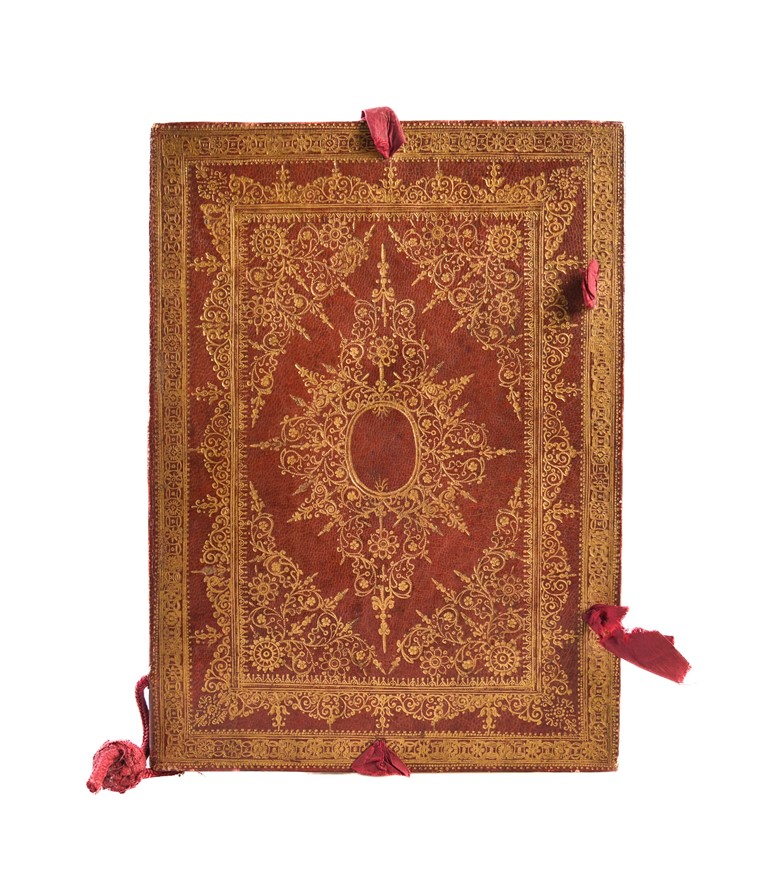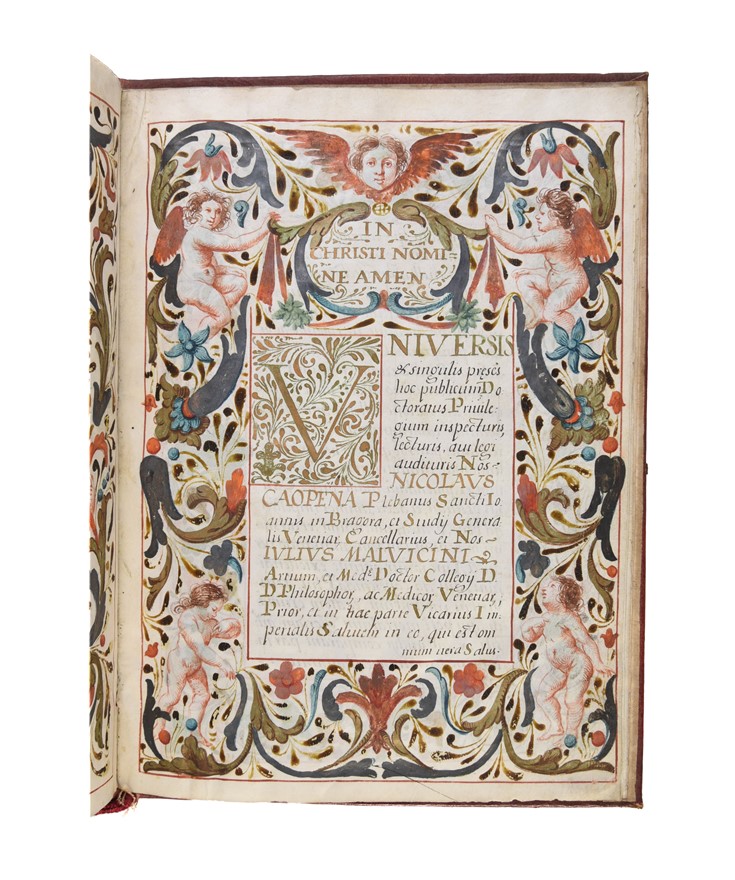Venetian doctoral diploma, illuminated manuscript on vellum.
DIPLOMA (1644)
£8000.00
Please contact us in advance if you would like to view this book at our Curzon Street shop.
DEGREE DIPLOMA FROM A PAPER UNIVERSITY
Latin manuscript on vellum [6 leaves] with illuminated frontispiece to verso of first leaf with double-headed eagle of the Holy Roman Emperor, presumably Frederick III, with unknown (Italian?) arms embedded, text in manuscript beginning on f.2r with 'In christi nomine amen' in cartouche, in gold and opening initial also illuminated in gold (along with subsequent upper case letters thereafter). First leaf with wide border with four, beautifully drawn and shaded putti and elaborate swathes of foliage in red, blue, yellow, gold and silver (oxidised), subsequent leaves with border of lavish foliage, 23 lines of text per page (excepting first, with 17), in a neat humanist hand.
4to [250 x 180mm]. Contemporary Venetian binding of red morocco, elaborately panelled in gilt with lavish central lozenge and corner decoration in central panel in pointillé style, remnants of four of six red silk ties, two survive in full, cord for wax seal at foot of spine, seal removed (minor rubbing to extremities).
Venice,
A handsome diploma certificate, lavishly illuminated and bound, conferring a doctorate in philosophy on Francesco Maria Ferro from the Collegio dei Medici, Venice. The diploma opens with an extravagant, full-page frontispiece, hand-painted, with central arms held by the double-headed eagle of the Holy Roman Empire, presumably in reference to Frederick III, who granted the Collegio its charter in 1469. Two half-length female figures stand below, and above are portraits of St Mark with the lion, the Virgin Mary, and, appropriately for a higher medical degree, St Julian the Hospitaller. Following pages are each adorned with a wide border of leafy foliage and flowers in blues, oranges, pinks and gold. The diploma is contained within a wonderfully preserved, Italian red morocco binding, elaborately gilt.
This 4to format with elaborate binding and illumination is found principally in degree certificates awarded at universities in the north of Italy, especially Venice, and Padova from the sixteenth century onwards. A tradition that persisted into the eighteenth century, it is the earlier examples, such as this one, that tend to be the most elaborate. While the text and elements of the format were relatively formulaic, they were commissioned by the graduating student and therefore are each unique.
The text of the document, pro-forma in nature, describes the process by which Ferro was examined for and awarded his degree. Named at the beginning are Nicolò Caopena, prelate of San Giovanni in Bragora and Chancellor of the 'studium generale' of Venice, and Giulio Malvicini, physician and prior of the Collegio. Also named later in the manuscript are Ferro's examiners (f.5r) and, on the final page, two avvocati as witnesses, Petro Gradenico and Giovanni Francesco Businelo (who also had a reputation as a librettist, 1598-1659). The degree is signed by Malvicini and by the attendant Venetian notary, Angelo Schietti. Little is known of the degree's recipient, Ferro. Venetian, as the diploma states, the scant trace we have found of him suggests that he was a physician and vicario pretorio in Padova subsequent to his degree.
The Collegio dei Medici in Venice was what Paul Grendler has called a 'paper university', which was 'a commune holding a papal or imperial charter and having colleges of doctors of law, arts and medicine or theology [which] could award university degrees even if little or no advanced instruction occurred. [...] Probably every major city in Italy had colleges of law and medicine composed of prominent local legists and physicians with doctorates. Their chief duties were to regulate the practice of law and medicine in the town. But when the Pope or emperor conferred a university charter on a commune, the local colleges of doctors of law, medicine and theology might also examine candidates and confer degrees. Of course, the candidates studied elsewhere. The most important paper university was the College of Physicians (the Collegio dei Medici) of Venice' (Grendler, p.140). The Collegio did not offer any teaching, nor did it have any pupils or permanent teaching staff. Instead, a medical student such as Ferro, here, would have pursued his studies at the University of Padua - the prime university that served Venice and the Veneto in this period - and then come to the Collegio dei Medici to have his degree conferred.
A standard part of the ceremony surrounding the awarding of the degree were symbolic gifts given to the student, and they are described here; first, books (f.6v) – ‘closed to symbolise the knowledge held within the books, then opened to signify that [he] would teach from them’ (Grendler, 177). Second, the three-cornered doctoral cap (f.6v-7r); and finally, a gold ring (f.7r), representing ‘the marriage between the doctor and his subject’ (Grendler, 177).
Provenance: From the library of W.A. Foyle (1885-1963) at Beeleigh Abbey, with his gilt exlibris on front pastedown. Founder of Foyle's bookshop in 1903, Foyle amassed one of the most extensive, and wide-ranging, private collections of books and manuscripts of the twentieth century, housed at Beeleigh Abbey, the twelfth-century monastery he purchased in the 1940s. After his death, his daughter Christina took on the estate and the collection; the majority was sold on her death in 1999, by auction at Christie's (The Library of William Foyle, July 2000); her nephew, William's grandson, Christopher (1943-2022) bought back some of the collection prior to the sale, possibly including this lot.
Very minor staining & smudging, opening arms a little rubbed but otherwise in excellent condition.
P.F. Grendler, The Universities of the Italian Renaissance (Baltimore: JHU Press, 2004)..
Stock Code: 251670






